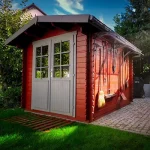
Phone Number
1-336-701-5589

Email Us
service@customeandp.com

Outdoor Wiring Project Safety Tips
- Custom Electric & Plumbing
- June 14, 2024
Safety Tips
This article will get you from dreaming about your next outdoor wiring project! From garden lighting solutions to powering you mobile home or RV in your driveway these tip will help you protect yourself as you plan your next project.
Using UEF-rated wire, which is designed to withstand outdoor conditions, is just one part of the equation. Most of these projects if not all of the projects in this outline will require this special wire to adhere to regulations and codes. I am in North Carolina so I will only mention my local regulations. Please research the laws specific to your area to understand more…
First we will outline some common outdoor projects and vaguely describe each situation and what to plan for. At the bottom will be details about regulations and links to NEC codes for reference.
Sheds and Workshops
 For sheds and workshops, it’s essential to determine the power requirements for lighting and ensure that large tools have dedicated receptacles. Calculating the total wattage of all light fixtures is necessary to ensure that lighting circuits can handle the load without exceeding 80% of the circuit breaker’s capacity. Identifying the power requirements for each large tool and installing dedicated circuits with appropriate breakers prevents overloading and ensures the safe operation of these tools. If the installation is outside, using weatherproof outlets and switches is crucial to protect against moisture. All outdoor electrical components must be rated for wet conditions (NEMA 3R, 4X) to ensure longevity and safety.
For sheds and workshops, it’s essential to determine the power requirements for lighting and ensure that large tools have dedicated receptacles. Calculating the total wattage of all light fixtures is necessary to ensure that lighting circuits can handle the load without exceeding 80% of the circuit breaker’s capacity. Identifying the power requirements for each large tool and installing dedicated circuits with appropriate breakers prevents overloading and ensures the safe operation of these tools. If the installation is outside, using weatherproof outlets and switches is crucial to protect against moisture. All outdoor electrical components must be rated for wet conditions (NEMA 3R, 4X) to ensure longevity and safety.
RV and Trailer Hookups
 When installing power hookups for RV trailers, it is vital to check that the hookup meets the voltage and amperage requirements of your RV, commonly 30A or 50A service. This involves installing the appropriate receptacles (NEMA TT-30R for 30A or NEMA 14-50R for 50A) to match your RV’s needs. Additionally, installing ground fault circuit interrupters (GFCIs) is necessary to prevent electrical shock hazards, particularly in wet or damp locations. GFCIs are a crucial safety feature that protects both the equipment and individuals from unwanted hazards.
When installing power hookups for RV trailers, it is vital to check that the hookup meets the voltage and amperage requirements of your RV, commonly 30A or 50A service. This involves installing the appropriate receptacles (NEMA TT-30R for 30A or NEMA 14-50R for 50A) to match your RV’s needs. Additionally, installing ground fault circuit interrupters (GFCIs) is necessary to prevent electrical shock hazards, particularly in wet or damp locations. GFCIs are a crucial safety feature that protects both the equipment and individuals from unwanted hazards.
Patio Lighting
 Choosing fixtures designed for outdoor use and ensuring they are weather-resistant is essential for patio lighting. These fixtures must be able to withstand outdoor conditions, with materials rated for wet or damp locations. To save energy, consider LED lighting for its long-lasting, energy-efficient properties, or explore solar-powered options to reduce energy consumption and simplify installation. These choices not only enhance the aesthetic appeal of your patio but also contribute to energy efficiency and ease of maintenance.
Choosing fixtures designed for outdoor use and ensuring they are weather-resistant is essential for patio lighting. These fixtures must be able to withstand outdoor conditions, with materials rated for wet or damp locations. To save energy, consider LED lighting for its long-lasting, energy-efficient properties, or explore solar-powered options to reduce energy consumption and simplify installation. These choices not only enhance the aesthetic appeal of your patio but also contribute to energy efficiency and ease of maintenance.
Pools and Spas
 For pools and spas, ground fault circuit interrupters (GFCIs) are required for all outlets within close proximity to water to prevent electrical shock. It is also crucial to ensure that all pool equipment is properly bonded and grounded to eliminate electrical hazards. Proper bonding and grounding create a safe environment around water, significantly reducing the risk of electrical incidents.
For pools and spas, ground fault circuit interrupters (GFCIs) are required for all outlets within close proximity to water to prevent electrical shock. It is also crucial to ensure that all pool equipment is properly bonded and grounded to eliminate electrical hazards. Proper bonding and grounding create a safe environment around water, significantly reducing the risk of electrical incidents.
Outdoor Lighting
 Outdoor lighting benefits greatly from using low voltage options, as they reduce the risk of electrical hazards in landscaping projects. These systems typically operate on 12V or 24V, enhancing safety. Additionally, it is important to ensure that transformers and all electrical connections are waterproof to withstand outdoor conditions and prevent electrical failures.
Outdoor lighting benefits greatly from using low voltage options, as they reduce the risk of electrical hazards in landscaping projects. These systems typically operate on 12V or 24V, enhancing safety. Additionally, it is important to ensure that transformers and all electrical connections are waterproof to withstand outdoor conditions and prevent electrical failures.
Outdoor Kitchens
 Outdoor lighting benefits greatly from using low voltage options, as they reduce the risk of electrical hazards in landscaping projects. These systems typically operate on 12V or 24V, enhancing safety. Additionally, it is important to ensure that transformers and all electrical connections are waterproof to withstand outdoor conditions and prevent electrical failures.
Outdoor lighting benefits greatly from using low voltage options, as they reduce the risk of electrical hazards in landscaping projects. These systems typically operate on 12V or 24V, enhancing safety. Additionally, it is important to ensure that transformers and all electrical connections are waterproof to withstand outdoor conditions and prevent electrical failures.
Garden Lighting
 Opting for solar-powered garden lights can make a significant impact by being relatively inexpensive and easy to install. Solar lights save energy and simplify installation since they do not require wiring. For wired setups, using timers can make them more cost-effective by reducing energy consumption. These solutions enhance the aesthetic appeal of gardens while being environmentally friendly and cost-efficient.
Opting for solar-powered garden lights can make a significant impact by being relatively inexpensive and easy to install. Solar lights save energy and simplify installation since they do not require wiring. For wired setups, using timers can make them more cost-effective by reducing energy consumption. These solutions enhance the aesthetic appeal of gardens while being environmentally friendly and cost-efficient.
Deck Wiring
 Concealing wires under the deck can enhance the aesthetics and add protection to your circuits. It is important to use only outdoor-rated outlets and covers to ensure safety and durability. Properly concealed and protected wiring prevents tripping hazards and extends the lifespan of your electrical installations by shielding them from the elements.
Concealing wires under the deck can enhance the aesthetics and add protection to your circuits. It is important to use only outdoor-rated outlets and covers to ensure safety and durability. Properly concealed and protected wiring prevents tripping hazards and extends the lifespan of your electrical installations by shielding them from the elements.
Landscape and Up Lighting
 Landscape and up-lighting can enhance features effectively, but it is crucial to ensure all electrical connections are protected from moisture to prevent shorts and corrosion. Regular safety checks are necessary, especially for hidden lights, to avoid damage and ensure ongoing safety and functionality. Properly installed and maintained landscape lighting can dramatically improve the appearance of your property while ensuring safety.
Landscape and up-lighting can enhance features effectively, but it is crucial to ensure all electrical connections are protected from moisture to prevent shorts and corrosion. Regular safety checks are necessary, especially for hidden lights, to avoid damage and ensure ongoing safety and functionality. Properly installed and maintained landscape lighting can dramatically improve the appearance of your property while ensuring safety.
Electric Fences
 Electric fences require the use of insulators to prevent accidental shocks. It is also important to clearly mark electric fences to warn others of the potential hazard. These measures ensure the safe operation of electric fences, preventing injuries to people and animals while maintaining the fence’s effectiveness.
Electric fences require the use of insulators to prevent accidental shocks. It is also important to clearly mark electric fences to warn others of the potential hazard. These measures ensure the safe operation of electric fences, preventing injuries to people and animals while maintaining the fence’s effectiveness.
Compliance and Safety

Schedule inspections to ensure all installations remain safe and compliant over time and when in doubt, hire a licensed electrician to handle complex installations. Building codes can change, so stay informed about any updates that may affect your project, by meticulously planning and adhering to these guidelines. You can achieve your outdoor construction goals safely and effectively, ensuring a durable and compliant electrical setup.
Proper Grounding: Ensure all outdoor electrical installations are properly grounded to prevent electrical shocks and fires. This is a critical safety measure. NEC 300.5
Conduit Requirements: Use the correct type of conduit to protect your wiring from physical damage and exposure to the elements. Conduit types can include PVC, metal, or liquid-tight flexible conduits.
Installation Depths: Follow the required installation depths for buried wires. Shallow installations can lead to accidental damage, while deeper installations offer better protection.
